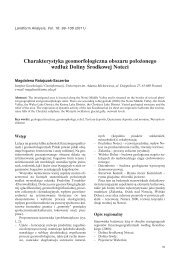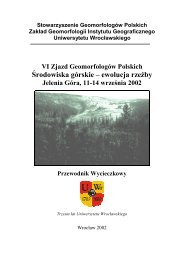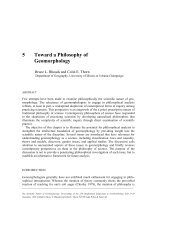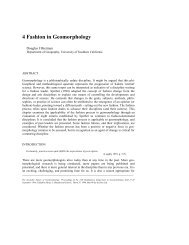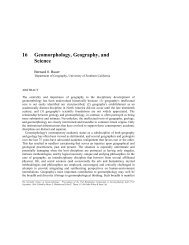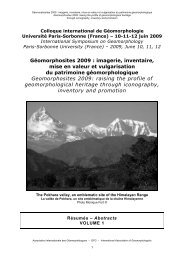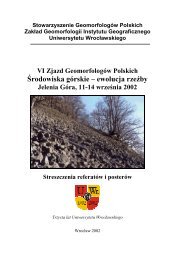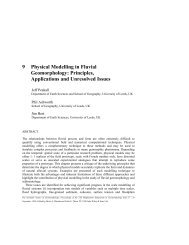Chapter 16 - Geomorphology, Geography, and Science Bernard 0
Chapter 16 - Geomorphology, Geography, and Science Bernard 0
Chapter 16 - Geomorphology, Geography, and Science Bernard 0
Create successful ePaper yourself
Turn your PDF publications into a flip-book with our unique Google optimized e-Paper software.
GEOMORPHOLOGY, GEOGRAPHY, AND SCIENCE 393<br />
zoology, or to careers as independent sciences' (Barrows 1923, p. 4). Such debates about<br />
the true (<strong>and</strong> desired) nature <strong>and</strong> substance of geography were not always articulate nor<br />
assertive (consider, for example, the ineffectiveness of the arguments put forth to avert the<br />
elimination of geography at Harvard as described by Smith 1987), but they obviously<br />
were necessary. There was some reluctance on the part of the majority of academic<br />
geographers to disown geomorphology completely because earth's physical surface was<br />
recognized as an essential component of geographical processes. Nevertheless, in the<br />
wake of widespread rejection of 'environmental determinism' <strong>and</strong> 'geographical influences'<br />
(e.g. Brigham 1903; Semple 1911), there was negative reaction to the historically<br />
privileged position of geomorphology <strong>and</strong> there was reluctance to admit it to positions of<br />
academic <strong>and</strong> intellectual power within geography. Further, the expansionist era<br />
associated with the American frontier <strong>and</strong> European colonization was coming to a close,<br />
<strong>and</strong> the new explorations were into social rather than physical spaces (Smith 1987, p.<br />
<strong>16</strong>8). <strong>Geomorphology</strong> was ignored, much like a child left to self-amusement in the midst<br />
of parental disputes about family finances. This was not unfamiliar territory for<br />
geomorphology - several decades earlier, geologists had 'left [geomorphology] behind,<br />
like a hapless rural milkmaid at the pit head, as the miner climbed below' (Tinkler 1985, p.<br />
80). To compound matters, there was a distinct absence of charismatic leaders with novel<br />
approaches to the subject, or at least, a reluctance to embrace such figures <strong>and</strong> their ideas<br />
professionally. As a consequence, North American geomorphology faded into the<br />
academic background of both geography <strong>and</strong> geology (Dury 1983). Most<br />
geomorphologists retained a Davisian outlook <strong>and</strong> were silently searching for evolutionary<br />
order in the ever-increasing stock of concordant surfaces, denudation chronologies,<br />
climatic anomalies, <strong>and</strong> variants thereof. Exceptions, of course, are many <strong>and</strong> have been<br />
remarked upon extensively (e.g. Tinkler 1985; Chorley et al. 1973; Beckinsale <strong>and</strong><br />
Chorley 1991; Yatsu 1992). Human geographers, on the other h<strong>and</strong>, were engaged in<br />
heated <strong>and</strong> protracted debates about how to interface more closely with the social sciences<br />
<strong>and</strong> the humanities <strong>and</strong> about what constitutes appropriate geographical subject matter,<br />
methods, <strong>and</strong> theories. Geographers participated in (<strong>and</strong> defended fervently) three types of<br />
activities through the war decades:<br />
1. They returned to their traditional roles involving the sterile, but careful <strong>and</strong> elaborate,<br />
collection, classification, <strong>and</strong> cartographic representation of worldly data especially<br />
pertaining to those places not yet explored.<br />
2. They embarked on holistic studies of particular places as unique <strong>and</strong> interesting<br />
entities.<br />
3. They engaged in generalizing <strong>and</strong> theorizing about earth-surface processes with the<br />
goal of formulating widely applicable laws to recurring events.<br />
Ensconced in these debates were hidden tensions regarding spatial versus temporal<br />
studies, idiographic versus nomothetic objectives, scientific versus humanistic methods,<br />
<strong>and</strong> the role of humans as passive versus active agents of change. At various times, then,<br />
geographers adopted concerns for human ecology (e.g. Barrows 1923), chorology (e.g.<br />
Sauer 1924, 1925), regionalism (e.g. Hartshorne 1939; Finch 1939), historical geography<br />
(e.g. Brown 1948; Sauer 1941), geomorphography (Kesseli 1946), antiexceptionalism<br />
(e.g. Schaefer 1953), <strong>and</strong> applied geography (Ackerman 1945).



